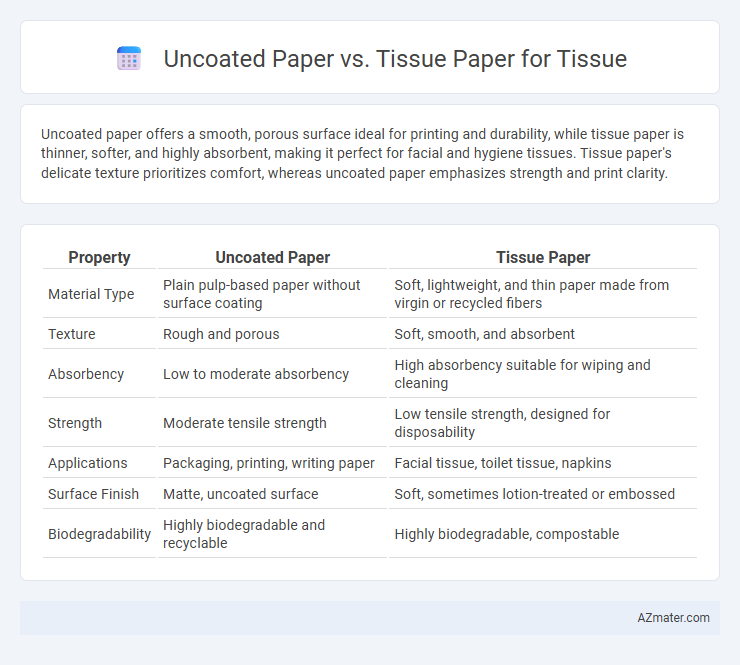Uncoated paper offers a smooth, porous surface ideal for printing and durability, while tissue paper is thinner, softer, and highly absorbent, making it perfect for facial and hygiene tissues. Tissue paper's delicate texture prioritizes comfort, whereas uncoated paper emphasizes strength and print clarity.
Table of Comparison
| Property | Uncoated Paper | Tissue Paper |
|---|---|---|
| Material Type | Plain pulp-based paper without surface coating | Soft, lightweight, and thin paper made from virgin or recycled fibers |
| Texture | Rough and porous | Soft, smooth, and absorbent |
| Absorbency | Low to moderate absorbency | High absorbency suitable for wiping and cleaning |
| Strength | Moderate tensile strength | Low tensile strength, designed for disposability |
| Applications | Packaging, printing, writing paper | Facial tissue, toilet tissue, napkins |
| Surface Finish | Matte, uncoated surface | Soft, sometimes lotion-treated or embossed |
| Biodegradability | Highly biodegradable and recyclable | Highly biodegradable, compostable |
Introduction to Uncoated Paper and Tissue Paper
Uncoated paper is characterized by its porous surface, absence of a coating layer, and higher absorbency, making it ideal for printing and packaging applications requiring a natural look and feel. Tissue paper, a thin and soft variant of paper, is specifically designed for hygiene and cleaning purposes, featuring high absorbency and gentle texture for skin contact. The key difference lies in uncoated paper's versatility in printing and wrapping, while tissue paper excels in disposability and comfort for personal care products.
Key Differences Between Uncoated Paper and Tissue Paper
Uncoated paper is typically thicker, more opaque, and has a rougher texture, making it suitable for printing and packaging applications, while tissue paper is thin, translucent, and soft, designed primarily for hygiene and cosmetic uses. Uncoated paper has greater durability and strength, whereas tissue paper prioritizes softness and absorbency. Key differences lie in fiber composition, with tissue paper often using recycled or virgin pulp for softness, contrasted by uncoated paper's firmer wood pulp structure that enhances print quality.
Manufacturing Processes of Uncoated Paper vs Tissue Paper
Uncoated paper manufacturing involves a wet-formed process where cellulose fibers are pressed and dried without any surface coating, maintaining a natural, porous texture ideal for printing applications. Tissue paper production employs a similar wet-pressed method but emphasizes thinner and softer sheets, often incorporating creping techniques that loosen fibers for enhanced softness and absorbency, suitable for hygiene products. Both processes rely on precise control of fiber refining, pressing, and drying to achieve distinct physical properties tailored to their functional uses.
Physical Properties and Texture Comparison
Uncoated paper exhibits a rougher texture and higher opacity compared to tissue paper, which is thin, lightweight, and highly pliable. Tissue paper's physical properties include superior softness and excellent absorbency, making it ideal for hygiene and cosmetic uses, while uncoated paper tends to have greater stiffness and durability suited for packaging. The dimensional stability of uncoated paper contrasts with the delicate, flexible nature of tissue paper, reflecting their different applications.
Absorbency and Softness: Which Performs Better?
Tissue paper excels in absorbency and softness due to its loosely woven fibers and higher porosity, making it ideal for delicate skin and effective moisture absorption. Uncoated paper, while generally smoother and less processed, often lacks the delicate texture and rapid absorbency of tissue paper, resulting in a less comfortable feel and slower moisture uptake. For applications prioritizing comfort and quick liquid absorption, tissue paper outperforms uncoated paper significantly.
Environmental Impact and Sustainability Factors
Uncoated paper typically has lower chemical processing, resulting in reduced environmental pollution compared to heavily processed tissue paper, which often requires bleaching and additives. Tissue paper, designed for softness and absorbency, generally uses more energy and water during manufacturing, increasing its environmental footprint. Sustainable alternatives prioritize recycled content, eco-friendly fibers, and certifications like FSC or PEFC to minimize deforestation and promote circular economy practices in both uncoated and tissue paper production.
Cost Analysis: Uncoated Paper vs Tissue Paper
Uncoated paper generally has a lower production cost due to its simpler manufacturing process and lower material requirements compared to tissue paper, which involves additional steps for softness and absorbency. Tissue paper, despite higher costs, justifies the expense in applications requiring enhanced softness, durability, and absorbency, vital for hygiene and comfort products. Cost analysis reveals that uncoated paper suits budget-sensitive, less demanding uses, whereas tissue paper commands premium pricing aligned with its functional advantages.
Best Applications for Uncoated Paper in Tissue Products
Uncoated paper in tissue products is ideal for applications requiring high absorbency and softness, such as facial tissues, napkins, and paper towels. Its natural fiber surface enhances ink absorption, making it suitable for printed tissue products with visible designs or branding. The biodegradable and eco-friendly nature of uncoated paper aligns with sustainable packaging trends in hygiene and personal care items.
Tissue Paper: Advantages in Hygiene and Everyday Use
Tissue paper offers superior hygiene benefits due to its softness, absorbency, and single-use design that reduces contamination risks compared to uncoated paper. Its lightweight, breathable structure ensures gentle skin contact, making it ideal for personal care applications such as facial tissues and bathroom tissue. Enhanced biodegradability and quick disintegration properties also improve environmental sustainability in everyday use.
Choosing the Right Material for Tissue Manufacturing
Uncoated paper offers a smoother surface and higher absorbency, making it ideal for facial and hygiene tissues, while tissue paper is thinner and softer, preferred for gentle skin contact in products like toilet paper and napkins. Selecting the right material depends on desired softness, strength, and absorbency characteristics critical for end-use performance in tissue manufacturing. Manufacturers prioritize fiber composition and processing methods to balance durability and comfort for targeted tissue applications.

Infographic: Uncoated paper vs Tissue paper for Tissue
 azmater.com
azmater.com